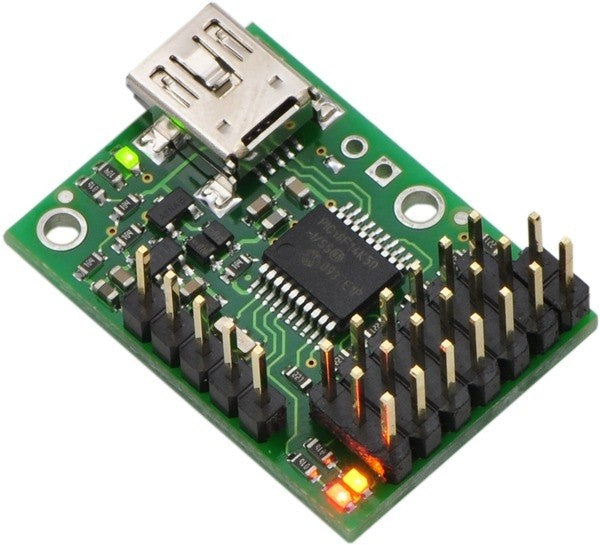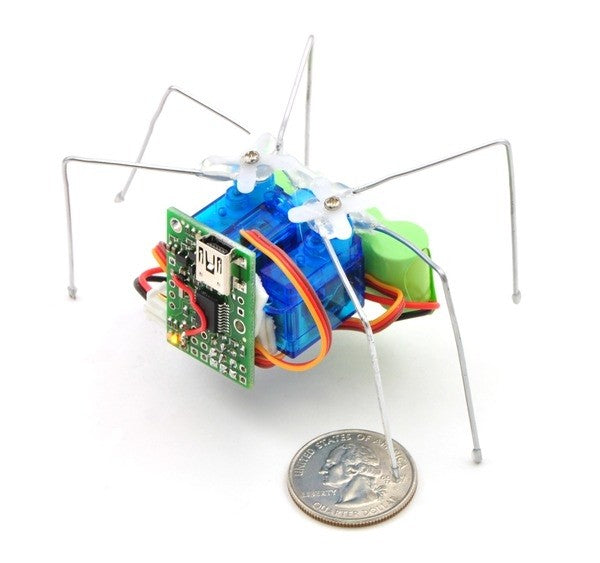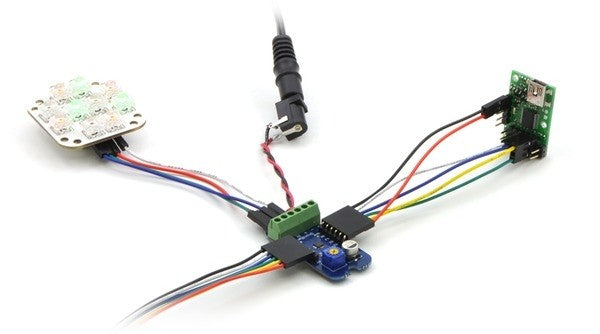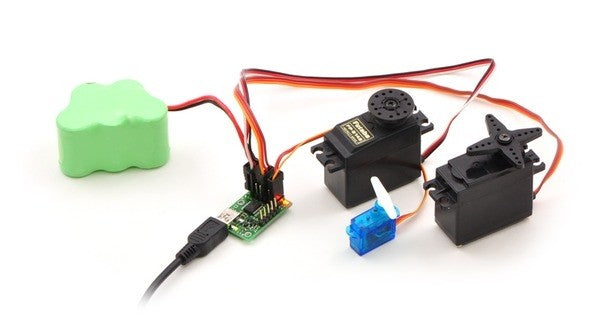Beschreibung
- Micro Maestro 6-Channel USB Servo Controller (Assembled)
- Micro Maestro 12-Channel USB Servo Controller (Assembled)
- Micro Maestro 18-Channel USB Servo Controller (Assembled)
- Micro Maestro 24-Channel USB Servo Controller (Assembled)

- Three control methods: USB, TTL (5V) serial, and internal scripting
- 0.25?s output pulse width resolution (corresponds to approximately 0.025° for a typical servo, which is beyond what the servo could resolve)
- Pulse rate configurable from 33 to 100 Hz (2)
- Wide pulse range of 64 to 3280 ?s (2)
- Individual speed and acceleration control for each channel
- Channels can be optionally configured to go to a specified position or turn off on startup or error
- Channels can also be used as general-purpose digital outputs or analog inputs
- A simple scripting language lets you program the controller to perform complex actions even after its USB and serial connections are removed
- Comprehensive user?s guide
- Free configuration and control application for Windows makes it easy to:
- Configure and test your controller
- Create, run, and save sequences of servo movements for animatronics and walking robots
- Write, step through, and run scripts stored in the servo controller
- Two ways to write software to control the Maestro from a PC:
- Virtual COM port makes it easy to send serial commands from any development environment that supports serial communication
- Pololu USB Software Development Kit allows use of more advanced native USB commands and includes example code in C#, Visual Basic .NET, and Visual C++
- TTL serial features:
- Supports 300 ? 200000 bps in fixed-baud mode, 300 ? 115200 bps in autodetect-baud mode (2)
- Simultaneously supports the Pololu protocol, which gives access to advanced functionality, and the simpler Scott Edwards MiniSSC II protocol (there is no need to configure the device for a particular protocol mode)
- Can be daisy-chained with other Pololu servo and motor controllers using a single serial transmit line
- Can function as a general-purpose USB-to-TTL serial adapter for projects controlled from a PC
- Board can be powered off of USB or a 5 ? 16 V battery, and it makes the regulated 5V available to the user
- Compact size of 0.85" × 1.20" (2.16 × 3.05 cm) and light weight of 0.17 oz (4.8 g) with headers
- Upgradable firmware

|
 |
 |
 |
|
|---|---|---|---|---|
| Micro Maestro | Mini Maestro 12 | Mini Maestro 18 | Mini Maestro 24 | |
| Channels: | 6 | 12 | 18 | 24 |
| Analog input channels: | 6 | 12 | 12 | 12 |
| Digital input channels: | 0 | 0 | 6 | 12 |
| Width: | 0.85" (2.16 cm) | 1.10" (2.79 cm) | 1.10" (2.79 cm) | 1.10" (2.79 cm) |
| Length: | 1.20" (3.05 cm) | 1.42" (3.61 cm) | 1.80" (4.57 cm) | 2.30" (5.84 cm) |
| Weight(1): | 3.0 g | 4.2 g | 4.9 g | 6.0 g |
| Configurable pulse rate(2): | 33?100 Hz | 1?333 Hz | 1?333 Hz | 1?333 Hz |
| Pulse range(2): | 64?3280 ?s | 64?4080 ?s | 64?4080 ?s | 64?4080 ?s |
| Script size(3): | 1 KB | 8 KB | 8 KB | 8 KB |
- 1 This is the weight of the board without header pins or terminal blocks.
- 2 The available pulse rate and range depend on each other and factors such as baud rate and number of channels used. See the Maestro User?s Guide for details.
- 3 The user script system is more powerful on the Mini Maestro than on the Micro Maestro. See See the Maestro User?s Guide for details.
- Serial servo controller for multi-servo projects (e.g. robot arms, animatronics) based on BASIC Stamp or Arduino platforms.
- PC-based servo control over USB port
- PC-based control of motors by interfacing with an ESC over USB
- PC interface for sensors and other electronics:
- Read a gyro or accelerometer from a PC for novel user interfaces
- Control a string of ShiftBrites from a PC for mood lighting
- General I/O expansion for microcontroller projects
- Programmable, self-contained Halloween or Christmas display controller that responds to sensors. The picture to the right and the video below show a self-contained hexapod robot that uses three micro servos and two digital distance sensors for autonomous walking.
- Self-contained servo tester

| Size: | 0.85" x 1.20" |
|---|---|
| Weight: | 4.8 g |
| Channels: | 6 |
|---|---|
| Baud: | 300 - 200000 bps1 |
| Minimum operating voltage: | 5 V |
| Maximum operating voltage: | 16 V |
| Supply current: | 30 mA2 |
| Partial kit?: | N |
- 1.Autodetect works from 300 - 115200 bps.
- 2.With USB disconnected and all LEDs on. Connecting USB draws around 10 mA more.
Verschlüsselte Zahlung
Ihre Zahlungsinformationen werden sicher verarbeitet. Wir speichern keine Kreditkartendaten und haben auch keinen Zugang zu Ihren Kreditkartendaten.
Zolltarifnummer:
Herkunftsland:
Das hängt davon da, wo Sie sich befinden. Nach Übergabe der Bestellung an UPS beträgt die Lieferzeit in Deutschland ca. 2-3 Tage, innerhalb Europas ca. 1 Woche.
Wir versenden unsere Artikel mit unserem Versandpartner UPS.
Wenn wir Ihre Frage noch nicht beantwortet haben, können Sie uns kontaktieren, und wir werden uns so schnell wie möglich bei Ihnen melden.







